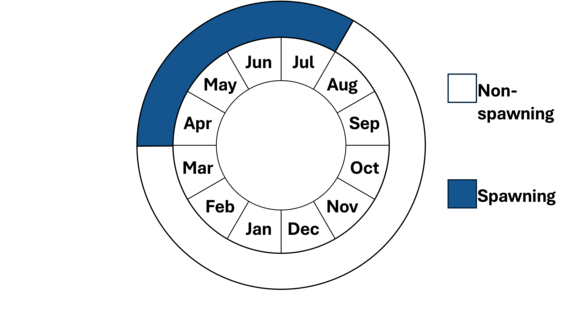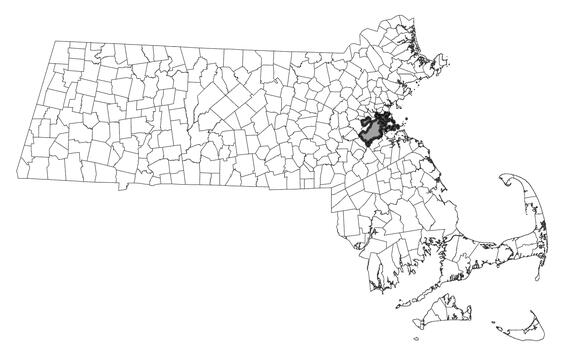- Scientific name: Gasterosteus aculeatus
- Species of Greatest Conservation Need (MA State Wildlife Action Plan)
- Threatened (MA Endangered Species Act)
Description

Threespine stickleback (Gasterosteus aculeatus)
The freshwater threespine stickleback is a very small, armored fish with three serrated dorsal spines. They are generally 25-38 mm (~1-1.5 in) in length. The marine populations are often larger, reaching up to 76 mm (~3 in) in length. Their pelvic fin consists of one spine and one soft ray. They are silvery yellow to light brown or green in color. During the breeding season, their breasts and bellies become bright red, and their eyes turn a vivid light blue in color.
Life cycle and behavior

The threespine stickleback has an interesting courtship ritual. Their spawning season is June or July, but spawning can continue throughout the summer. Males generally construct barrel-shaped nests out of vegetation and detritus in sandy, shallow areas. Males attract females by doing a “zigzag” dance, which leads the female into the nest where she deposits her eggs. Males will mate with multiple females. The males are then left to care for the eggs and young until they can fend for themselves. Males can often be seen “fanning” the nest to ensure that the eggs get enough oxygen. They become sexually mature in a year and may live up to 3 years. Threespine sticklebacks are voracious eaters and will eat worms, aquatic insect larvae, plants, fish eggs and fry, including their own species.
Distribution and abundance
Threespine sticklebacks can be found in both marine and freshwater environments. However, one population of threespine stickleback is threatened in Massachusetts. As with all species listed in Massachusetts, individuals of the species are protected from take (collecting, killing, etc.) and sale under the Massachusetts Endangered Species Act. This population is important because it is the southernmost, completely freshwater population known and the only freshwater population in Massachusetts. In addition, this population has three distinct lateral-plate morphs and is only the fourth record of low-plate individuals in eastern North America. The threespine stickleback’s body is armored on the sides by a series of large, oblong, vertical bony plates, called lateral plates. The three types of lateral-plates morphs (or forms) for this population of threespine stickleback are: 1) completely plated or plates along the entire side of the fish starting behind the gills; 2) medium-plated, or plates only along the anterior half of the body, and 3) low-plated, where there are only a couple of plates and the rest of the body is plate-free. Because this species has three different forms and different populations have some forms and not others, they are especially interesting to evolutionary biologists. Hundreds of individuals have been recorded annually in the past 25 years in this population, however, more recent annual surveys suggest a potential extirpation event from its known small pond habitat. Changes in pond hydrology, introduction of nonnative fish species, or other stressors may have triggered an emigration event to downstream waters.

Distribution in Massachusetts. 2000-2025. Based on records in the Natural Heritage Database.
Habitat
The freshwater population of threespine stickleback inhabits a clear, small spring-fed pond and small stream outflow in coastal eastern Massachusetts. The substrate is predominantly sandy and silty with build-ups of organic matter. Water depths are shallow ranging up to 0.9 m (3ft) and typically 0.3 m (~ 1ft). Threespine stickleback are the only fish inhabitants of the pond with no clear predators.
Healthy habitats are vital for supporting native wildlife and plants. Explore habitats and learn about conservation and restoration in Massachusetts.
Threats
Threats to this small freshwater population of threespine stickleback include alterations in pond hydrology, chemical runoff, introduction of nonnative and native predators to the pond, pondshore erosion and increased pond sedimentation.
Conservation
Survey and monitoring
In collaboration with DCR, management for this species focuses on habitat protection and restoration to improve in-pond habitat (large wood cover), promote pondshore stabilization to decrease pond sedimentation and improve water quality.
Management
Management for this species focuses on habitat protection and restoration such as improvements to streamflow, dam removal, culvert replacement, and riparian and streambank restoration. Protection of forested riparian zones and watersheds is critical for maintaining high water quality and cooler water temperatures.
Research needs
Effort is needed to reassess the status of the freshwater threespine stickleback population through surveys within the pond and waterbodies upstream and downstream. Surveys may include a suite of methods to maximize species detection including seining, snorkeling, minnow trapping, and eDNA water collections.
References
Hartel, K.E., Halliwell, D.B., Launer, A.E. Inland Fishes of Massachusetts. Lincoln, MA: Massachusetts Audubon Society, 2002.
Contact
| Date published: | April 10, 2025 |
|---|